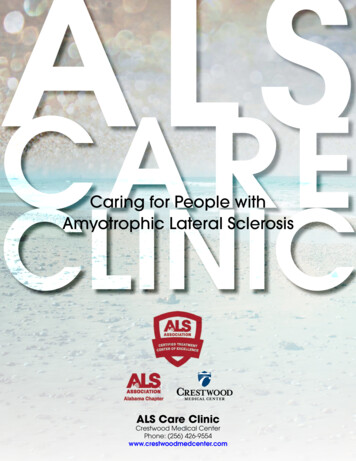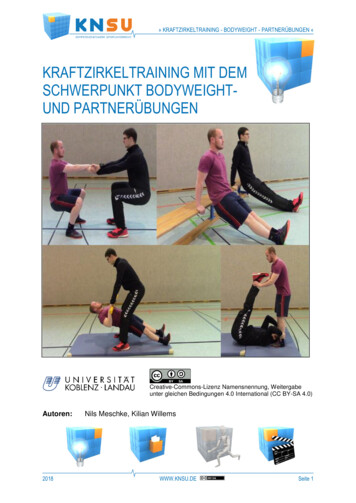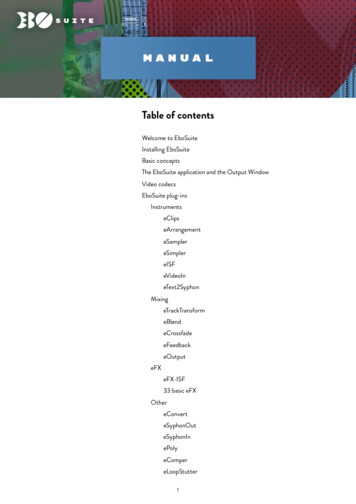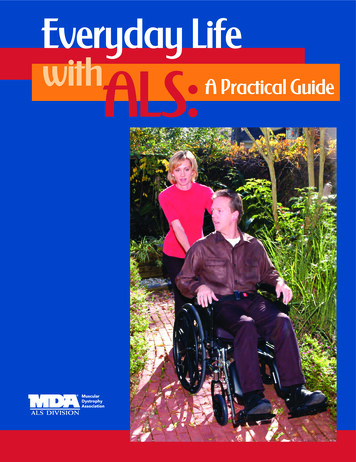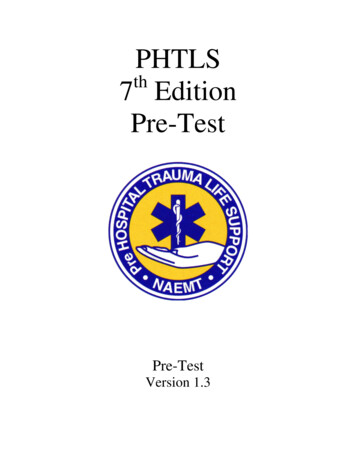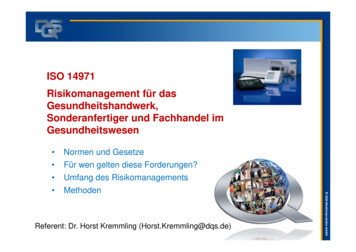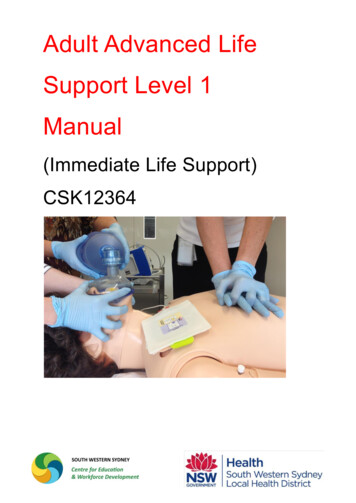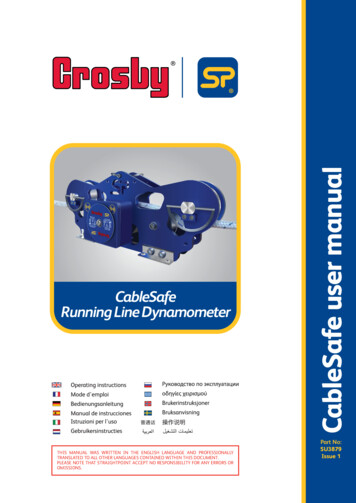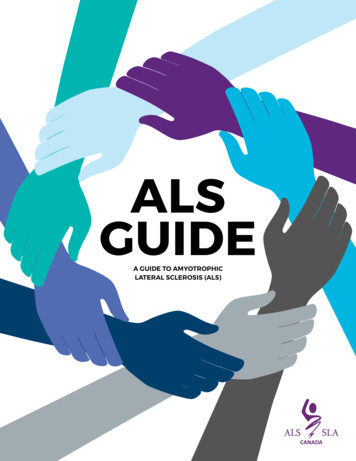
Transcription
ALSGUIDEA GUIDE TO AMYOTROPHICLATERAL SCLEROSIS (ALS)
ALS GUIDEINTRODUCTIONReceiving a diagnosis of ALS can be overwhelming. You mayday-to-day challenges of living with ALS. It is meant toexperience many different emotions, and you may feel thecomplement your primary source of information – theneed to learn more about how this complex disease willhealthcare team managing your ALS.affect you. Some people want to know as much as possible,often right after diagnosis. Others prefer to take a gradualapproach as changes occur and as the need for specificinformation develops. Take the approach that works bestfor you. Family members and close friends may also wishto learn more about ALS.The ALS Guide has been developed to provide practicalinformation about ALS, its progression, and how people andfamilies living with ALS can find solutions to help maintainindependence. There are different versions of this guide.All of the content is the same except for the informationabout the local delivery of care and services, which can bedifferent from province to province.The purpose of the ALS Guide is to help people and familieswith ALS plan for the physical, emotional, and financialchallenges ahead and to offer tips and support for theACKNOWLEDGEMENTSThis ALS Guide is a project of the FederationCouncil of ALS Societies across Canada –Client Services Committee.The 2019 edition of the ALS Guide in Englishand French is built upon the premise ofprevious editions of the ALS Manual, withnew and exciting, up to date information.Thank you to staff at ALS Canada whoresearched and wrote the majority of thecontent with expertise from numeroushealthcare providers and people living withALS, their caregivers and other experts.Thank you to the Client Services Committeefor their diligence and hard work indeveloping this Guide. Each provincial ALSSociety developed content for segmentsspecific to their region. The ALS Guide isstronger as a result of all the thoughtfulfeedback.Appreciation is also given for the languageeditor, translators, and designer whosecontributions were critical to this ALS Guide.This guide will be updated on an ongoingbasis to reflect changes about ALS, careALS GUIDE2and treatment, research and provincialspecific information.We hope that the ALS Guide provides youand your family with helpful information.Diana Rasmussen, Executive Director, ALSSociety of Manitoba and Chair of the ClientServices CommitteeLisa Droppo, Vice President, Client Services,ALS Canada and ALS Guide Project Manager.
ALS GUIDEHOW TO USETHE GUIDE01This guide is divided into seven main02sections, which means you can refer easilyto the information you need when you needit. You may prefer to skim through the guideor choose certain sections to read first.It is not necessary to read the guide all atMY ALS SOCIETYPAGE 6How port youfamilythroughthisthisjourney.journey.ABOUT ALS9PAGE 8Facts about the disease03AFTER THE DIAGNOSIS15PAGE 16The journey from diagnosis to planningfor the road ahead. Includes advice ononce. You may pick sections that you wantcommunicating the news, tips on coping,to read yourself and others you want totools to help you plan, and informationshare with family, friends, and caregivers.on legal, social, and financial supportsavailable.04LIVING WITH ALSPAGE 36Detailed information about major changesto the body and how to manage everydayroutines.05FOR CAREGIVERSPAGE 68How caregivers can deal with commonemotions, manage stress, and receivesupport.06RESEARCH AND ALS07ADDITIONAL RESOURCESPAGE 84Research and clinical trials.PAGE 88Additional reading suggestions areorganized by topic.While every effort has been made to provide up-to-date content at the time of publication, certain information – particularlyin the area of research and clinical trials – may change faster than we can update the guide. To stay updated, please refer tothe ALS Society in your province and ALS clinical specialists from time to time for new information.Disclaimer: The information in this publication has come from sources that the ALS Society of Canada deems reliable and is provided for general information purposesonly. It is not intended to replace personalized medical assessment and management of ALS. The ALS Society of Canada disclaims any liability for the accuracy thereof, anddoes not intend to disseminate either medical or legal advice. Throughout this publication, people with ALS are advised to consult with healthcare and legal professionalsfor medical and legal advice, respectively.ALS GUIDE3
ALS GUIDESECTIONS01MY ALS SOCIETY02ABOUT ALSSUB SECTIONS2A What the Name Means2B How ALS Affects the Body2C How do You Get ALS? What Are the Risk Factors?2D Diagnosing ALS2E Spinal/Limb Onset ALS2F Bulbar Onset ALS2G ALS and Cognitive Changes03AFTER THE DIAGNOSISFirst Steps:3A Register with Your local ALS Society3B Communicating the NewsThroughout the disease:3C Strategies for Coping with ALS3D Strategies for Helping Children Cope with ALS3E Participating in the ALS Community3F Your Healthcare Team3G Planning for Your Illness3H Financial, Social and Legal Assistance04LIVING WITH ALS4A Overview4B Tools for Staying on Track4C Mobility and Independence4D Swallowing, Nutrition and Oral Health4E Speech, Communication and Assistive Devices4F Breathing4G Cognitive Changes4H Relationships and Intimacy4IEnd of Life and Advance Care PlanningALS GUIDE4
ALS GUIDESECTIONS05FOR CAREGIVERSSUB SECTIONS5A Who Caregivers Are and What They Do5B You Are Not Alone5C Recognizing and Understanding Common Caregiver Emotions5D Compassion Fatigue5E Reducing Caregiver Stress and Compassion Fatigue5F Taking Care of Yourself5G Supports and Services for Caregivers5H Dealing with Bereavement5J06RESEARCH AND ALSBeyond Bereavement6A Overview6B Clinical Trials6C Research Partners6D Genetics and Research07ADDITIONAL RESOURCESALS GUIDE5
ALS GUIDE1.0MY ALS SOCIETYABOUT USThe ALS Society of CanadaWe work with the ALS community to improve the lives of peopleaffected by ALS through community-based support in Ontario,advocacy and investment in research for a future without ALS.Our values permeate and guide the work that we do:ACCOUNTABILITY, COLLABORATION,COMPASSION, INTEGRITY,RESILIENCY, AND RESPECT.Our Location393 University Avenue, Suite 1701Toronto, ON M5G 1E6Our Contact InformationTel: 416-497-2267Toll free: 1-800-267-4257Fax: 416-497-8545Email: info@als.caALS GUIDE6
ALS GUIDEOUR CLIENT SERVICES PROGRAMSRegional managersEducation, information, and resourcesALS Canada has a team of regional managers inPeople living with ALS/MND and their families oftencommunities across the province who assist peopleask for information about the disease, ongoingand families living with ALS/MND in navigating theirresearch, and the support services that are availablejourney. They do this through:to them. They also ask for help with access to In-home visits, phone calls, emails, and virtualassistive equipment, home care, and other support.connections to discuss individual and family needsALS Canada strives to be a leader in obtaining and Providing emotional and educational supportproviding information relevant to ALS/MND and Acting as a liaison between people living with ALS/about services available to those affected by theMND and healthcare and community servicesdisease. We offer a number of resources, from Participating in multidisciplinary ALS/MND clinicsprint material such as this ALS Guide and factwhen possible to provide additional support to clientssheets, to free research-focused webinars. ForAdvocating on behalf of clients and their familiesmore information and access to these resources,when they need assistance and when they havecontact your ALS Canada regional manager or visitconcerns during their ALS/MND journeyals.ca/guide-resources.Support groupsAdvocacyALS Canada hosts support groups across the provinceAt ALS Canada, we see firsthand and understand thein select communities so that people living with ALS andtremendous impact of an ALS diagnosis–physically,their caregivers can share experiences and emotionspsychologically and financially–and they reinforcewith people in similar situations. Support groups are athe need for better government support and accessgreat opportunity for people living with ALS and theirwithin the health care system.caregivers to learn from each other. Depending on theThat is why we engage with officials in the federal andarea, support groups may be caregiver only, client only,or a mixed client-caregiver group. To find the closestsupport group to you, contact your ALS Canada regionalmanager or visit als.ca/guide-regional.Ontario governments to represent the voices andexperiences of people living with ALS. We advocatefor policy changes that will have a meaningful impacton people living with ALS today and in the future,including equitable, timely and affordable accessto therapies, improved home and community care,Assistive equipment programresearch funding and more.ALS Canada offers an Assistive Equipment Program toWe also engage at the local level with health carehelp clients continue living safely and comfortably in theirproviders and agencies to help the people wehomes. The program is made up of three sub-programs:support access services and other resources thatthe Equipment Loan Program, the Equipment Fundingcan lessen the burden of living with ALS. To learnAssistance Program, and the Flexible Funding Program.more about our advocacy initiatives, visit als.ca/For more detail on each program and how to accessguide-advocacy.it, please refer to the ALS Canada Equipment ProgramOverview & Information at als.ca/guide-equipment.ALS GUIDE7
ALS GUIDEGET INVOLVEDParticipateVolunteerWalk To End ALSALS Canada relies on the time and talents of dedicatedvolunteers in so many ways. Learn more about how you canThe Walk to End ALS is the largest volunteer-led fundraiseruse your expertise and talents to support the ALS community,for ALS Societies across Canada. Family-friendly and fun, itcontact volunteer@als.ca.unites Canadians in their desire to put an end to ALS.DonateFind a Walk near you: walktoendals.ca/alsguide.Help people and families living with ALS today, while supportingCommunity Eventstomorrow’s ALS treatments. Make your donation at als.ca/Local fundraising events are fun, rewarding and easy. Createdonate or contact donations@als.ca to speak to one of ouryour own event at als.ca/guide-events.team members about other ways to give.ALS GUIDE8
ALSALS GUIDEGUIDE2.0ABOUT ALSAmyotrophic lateral sclerosis (ALS), often known asLou Gehrig’s disease, is the most common form ofmotor neuron disease (MND).In French, ALS is called sclérose latérale amyotrophique (SLA) or maladie de Charcot.The first full account of ALS symptoms was published in 1874 by Dr. Jean-MartinCharcot, a French neurologist and founder of the field of modern neurology.Other less common types of MND are primary lateral sclerosis (PLS) and Kennedy’sdisease.Throughout this guide, we will use the shorter abbreviation ALS to refer to ALS/MND.2AWHAT THE NAME MEANSAmyotrophic Lateral Sclerosis stands for:a absencemyo muscletrophic nourishmentlateral side (referring to the spine)sclerosis hardening or scarring.ALS GUIDE9
ALS GUIDE2BHOW ALS AFFECTS THE BODYALS affects the motor neurons of your body, causing voluntary muscles to atrophy (deteriorate and weaken). Voluntarymuscles are muscles that are under an individual’s conscious control. These muscles include the ones in the arms, such asthe biceps and triceps. The muscles of the face, neck, and tongue are also voluntary muscles that allow you to eat, supportand move your head, and make facial expressions. Muscles that are not under an individual’s conscious control, such as theheart muscle, are called involuntary muscles.What are motor neurons?Figure 1. Nervous systemCentral Nervous SystembrainMotor neurons are cells in the nervous system. They’re alsospinal cordcalled nerve cells. Your nervous system is what your bodyuses to communicate with your muscles and organs to reactPeripheraland adapt to things happening around you. Your nervousNervoussystem spreads across your entire body but is controlled bySystemyour brain and spinal cord, which is known as your centralnervous system (Figure 1).ganglionnerveNerveFigure 2. Motor NeuronnucleusTo be able to talk to your muscles, your nervousaxonnerve endingsystem uses motor neurons (Figure 2). They are likethe “messengers” of your nervous system. So, if yousheathcytoplasmwant to move your arm, your brain will send a signal,or message, to your arm muscles using motor neurons.cell membraneALS GUIDE10
ALSALS GUIDEGUIDEThe two main groups of motor neurons are the upper andFigure 3. Upper and lower motor neuronslower motor neurons (Figure 3).upper motor neuronsUPPER MOTOR NEURONSbrainstem (bulbar)lower motor neuronstell your lower motor neurons whenand how to move your muscles.axon bundles(nerves)rib musclesinvolved in breathingspinal lowermotor neuronsLOWER MOTOR NEURONSsend signals directly to your musclesto tell them to move according tothe directions of the upper motorneurons.When you have ALS/MND, your motor neurons startWHAT HAPPENS TO MOTORNEURONS WITH ALSto die. As they die, your brain is no longer able tosend the message to your voluntary muscles thatthey need to move a certain way.When you have ALS, your motor neurons start to die. AsALS is a disease that decreases life expectancy. There arethey die, your brain is no longer able to send messages tosome treatments and no known cures. As a result, 80% ofyour voluntary muscles telling them to move. This meanspeople with ALS have a life expectancy of two to five yearsyour muscles atrophy. Over time, ALS spreads throughoutafter diagnosis. How fast a person loses the use of theirthe body and atrophies all voluntary muscles, eventuallymuscles can vary significantly from person to person. Someweakening muscles required for breathing and leading todeteriorate rapidly, while others have long periods of veryrespiratory problems.slow degeneration.ALS affects both upper and lower motor neurons. If onlyALS does not typically affect the five senses: sight, hearing,upper or only lower motor neurons are affected it is not ALStaste, smell, and touch. It also does not usually affect thebut a different disease.heart. Recent studies have shown that some people with ALSmay experience a reduced ability to smell or detect odours.ALS GUIDE1011
ALS GUIDE2CHOW DO YOU GET ALS?ALS is not contagious, and you did nothing to cause it. It’s not your, or anyone’s, fault.WHAT ARETHE RISKFACTORS?A small number (10% or less) of people have familial (or hereditary) ALS. The rest (90% or more)are random (or sporadic) ALS diagnoses. As the name “random” implies, anyone can develop ALS,including young adults and the elderly. On average, the disease tends to show the first symptomsin the mid- to early senior years. It is most commonly diagnosed between the ages of 40 and 70.ALS is diagnosed in both men and women of all ethnic and socio-economic groups.Most of the risk factors are things you can’t do anything about:RISKFACTORSGENETICSAGEFor information about theThe risk of getting ALSgenetics of ALS, please seeincreases with age.Section 6: Research and ALS.HEREDITYMost people with the familialSMOKINGSmoking is the only environmentalform of ALS have a 50%factor to be recognized aschance of passing the diseasehaving a direct influence onto each child.increasing the risk of developingALS. Studies have shown thatsmokers are about twice as likelyto develop ALS as those whohave never smoked, while thosewho are former smokers have amoderately increased risk.ALS GUIDE1112
ALSALS GUIDEGUIDE2DDIAGNOSING ALSThe onset of ALS can be subtle and thesymptoms are often overlooked untilweakness is obvious enough to causea doctor to suspect ALS. ALS is often TrippingHowever, as the disease progresses, Dropping things Difficulty with simple tasks such asmuscles will continue to weaken. Asbuttoning a shirt or turning a keydiagnosed by ruling out other diseasesit spreads throughout the body, it willbecome more apparent that the causeis ALS through a process of elimination.and conditions first. This is because Slurred or “thick” speechso far, there is no test specifically to Muscle cramping, weakening andusual process of diagnosing ALS includestwitchingan electromyography (EMG) test, blooddiagnose ALS. Usually, the diagnosis ismade by a neurologist.In addition to a physical examination, theSome people with one or more earlytests, magnetic resonance imaging (MRI),Early symptoms of ALS can includesymptoms may simply think they areand other tests to search for the possiblethe following:experiencing normal signs of aging.presence of other diseases that exhibitsymptoms similar to those of ALS.2ESPINAL/LIMB ONSET ALSThe most common type of ALS is spinal or limb onset ALS. As the name indicates, limbs (arms and legs) are usually the firstareas to be affected. Usually, symptoms begin in either the arms or the legs, not both at once.Symptoms of spinal/limb onset ALSSymptoms of lower limb onset ALS includeSymptoms of upper limb onset ALS include Tripping Stumbling Cramping in the arm or hand Difficulty running properly Weaker hands Foot drop (foot slapping down on the ground Stiffness in the arms or handsLess finger dexteritywhen walking rather than rolling smoothly)Both types of limb onset ALS have other symptoms that indicate whether upper or lower motor neurons are beingaffected first. Signs of lower motor neuron degeneration include: Muscle weakness and atrophy Involuntary twitching of muscles (known as fasciculations) Muscle cramps Weakened reflexes Flaccidity (decreased muscle tone) Difficulty swallowing Inability to articulate speech Shortness of breath at restSigns of upper motor neuron degeneration include Muscle stiffness or rigidity Increased or hyperactive reflexes Emotional lability (a decreased ability to control laughing or crying)ALS GUIDE1213The sequence of symptoms and the rateof disease progression may vary fromperson to person.
ALS GUIDE2FBrain 4.CrossSection tractFigureCorticobulbarBULBAR ONSET ALSIn about 20–25% of ALS cases, the muscles for speaking,swallowing, and/or breathing are the first to be affected.This is known as bulbar onset ALS. The term “bulbar” refersto the motor neurons located in the corticobulbar area ofthe brainstem (Figure 4), which control muscles of the face,head, and neck. Bulbar ALS often progresses faster thanlimb onset ALS.ponsIn rare cases, the respiratory muscles are the first to becerebellumaffected, and the disease may be classified separately asspinal cordrespiratory onset ALS. People with this type of ALS may bereferred directly to acute respiratory care instead of to anALS clinic or a neurologist.Symptoms of bulbar onset ALSSymptoms of bulbar ALS include the following Changes in voice and speech Harsh, hoarse, or strained voice Whispery voice (as a result of the vocal cords not foldingas they do normally allowing more air to escape duringspeech) Poor articulation Less vocal range Quieter voice Spasms in muscles of the jaw, face, voice box, throat,or tongue Involuntary excessive laughing and crying Brisk jaw jerks Involuntary twitching in muscles of the tongue Vocal cord spasms causing the sensation that air cannotbe moved in or outIf you have bulbar ALS, talk to your ALS clinic team aboutdietary changes, communication devices, speech therapy,and medications that can help maintain your quality of life.ALS GUIDE1314
ALSALS GUIDEGUIDE2GALS AND COGNITIVE CHANGESAlmost half of people diagnosed with ALSorganizing, and managing life functionsApproximately 35% of patients with ALSwill experience some level of cognitive(or executive functions); increasedexperience clinically relevant cognitivechange. Cognitive change means that theapathy; changes in language (writtenimpairment, with an additional 15%way a person thinks, knows, perceives,or oral expression) and comprehension,having frontotemporal dementia (ALS-and understands the world around themincluding decreased verbal fluencyFTD). There is greater complexity tobecomes altered, which may or mayand speech impairment; inattentionthe spectrum of cognitive changesnot lead to differences in the way theor forgetfulness; bouts of irritability,detailed within the diagnostic criteriaperson acts.apathy and/or anxiety and depression.defined by Dr. Mike Strong and team.Most commonly, people with ALSMild cognitive alterations are oftenFor more information, please refer torecognized only through neurologicalthe Resource Section under ALS andtesting, whereas moderate changesCognitive Changes.experience only mild to moderatecognitive changes. Mild effects includealterations in planning, reasoning,may be more noticeable.BrainSigns and symptoms offrontotemporal dementiaFigure 5. Frontal and temporal lobesfrontal lobe Restlessness Recurring sudden mood swings Loss of reasoning or problemsolving abilitytemporal lobe Repetitive behaviours Socially inappropriate behaviour Impulsiveness and loss ofinhibitionsFrontotemporal dementia Memory lossFrontotemporal dementia is a progressive brain disease Balance and/or movementproblemsinvolving loss of neurons in the frontal and temporal lobes ofthe brain (Figure 5), which are areas of the brain responsible for rational thought, impulse control, and personality. UnlikeProblems with speech and/orlanguageAlzheimer’s disease, severe behavioural changes are usuallythe first signs to develop in FTD rather than memory loss,which may not occur at all.Both FTD and ALS occurring at once is referred to as ALSfrontotemporal spectrum disorder.ALS GUIDE1415
ALS GUIDE3.0FIRST STEPS: HELPING YOU ANDYOUR FAMILY NAVIGATE THEJOURNEY3AREGISTER WITH YOUR LOCAL ALS SOCIETYProvincial ALS societies provide comprehensive, accurate, and timely information about the disease and offer services andsupport to those living with ALS/MND (referred to here as ALS), their caregivers, and their families. Your provincial ALS Societycan help you navigate the healthcare system and connect you with health and community services available in your area.Register with your provincial society and take advantage of its services. See the “My ALS Society” section for more information.3BCOMMUNICATING THE NEWSYou will most likely need a few days or weeks to process yourKeep in mind, though, that your loved ones are experiencingdiagnosis. For some people it takes longer to be able to talkemotional reactions to your diagnosis too, which is normal.about their situation, and that’s okay. Everyone’s experienceNo one should feel guilty about any of their feelings. Keepingwith the disease is different.the lines of communication open is the best way to work outYou may be anxious about how and when to communicate thefeelings on both sides.news. You may prefer to take some time to process the newsCommunicating the news to childrenyourself. You may wish to find out more about the disease,Many people hope they can protect children from difficultconsider its long-term implications, and think about how yousituations by not explaining how bad the disease really is.wish to manage things before discussing it with family andBut all children, no matter how old they are, should be toldfriends. That’s all okay.the truth in a way they can understand. Children, even veryBut don’t wait too long. Talking with others can help youyoung ones, can pick up on emotional changes in a family.process the news yourself and can be a first step in gettingExcluding them from the conversation can easily make thememotional and practical support. If you find it hard to talkmisunderstand why emotions have changed and could evenabout, it may be useful to talk with a member of your ALS caremake them think they did something wrong and that theyteam, your ALS Society representative, a friend, a co-worker,are to blame. This type of thinking can be more harmful toor a counsellor. They may be able to help you and your lovedtheir well-being than telling them the truth and sharing theones talk to each other in a way that works for you. It is mostfamily’s experience.important that you have someone to talk to who will not beThere may be signs that indicate you need to talk to yourupset by what you are saying.children about your diagnosis sooner rather than later. ForA practical strategy may be to tell a few key people and askinstance, if children start asking questions about noticeablethem to break the news to everyone else you wish to inform,changes in your situation, appear withdrawn, or show anxiety,once you’ve given those key people clear, accurate information.they need to be told what’s happening.ALS GUIDE1516
ALSALS GUIDEGUIDEEven though it is important to talk to children about theThey may also ask,disease, it’s also important not to overwhelm them with What exactly does the sick person have? Will I catch it?disease is progressing. Many children will guide the pace at What will happen to the sick person? Will they die?which information is given by asking questions, for example.These are all normal questions for a child to ask.Starting the conversationWhen answering a child’s questions, be honest. Don’t be afraidinformation. The pace, amount, and type of information youprovide will depend on how old the child is and how theto say, “I don’t know” or “the doctor doesn’t know.” ChildrenThe words you choose are extremely important: clear, simple,do pick up when you are not being honest with them, and thiscorrect, and precise words are best. This will help limitcan make them wonder if you are hiding something. Even ifconfusion and misunderstanding.you don’t know the answer, the types of questions childrenThe conversation may not be easy, especially if you are tryingask will give you some idea of what they are worried about.to explain ALS to children when you yourself may not quiteSlowly, give more information about the disease and itsunderstand the disease. But starting an ongoing conversationprogression. It helps a child when they feel an adult is inwith a child can have positive effects on their thinking andcontrol. It is also important to keep reminding them that theybehaviour throughout the course of the disease.will continue to be cared for as the family faces the challengesStart the conversation by referring to things the child alreadyof ALS progression. Talking about how you plan to manageknows. For example, if ALS is affecting their father’s legs, youday-to-day family activities will help children feel more at ease.could say,If your child won’t talk about it“Not asking any questions does not mean the child is notYou know your dad has been having troubleinterested or not thinking about the situation. Some childrenwalking lately. He has been to the doctor, whomay need time to process the first conversation before theyhas told him he is sick. He has something calledask questions. Other children may need a little coaxing to asktheir questions. Some children may feel too afraid of whatALS and it’s going to make it more and moredifficult for him to walk.”they will hear to ask anything.The important thing is to establish good communication sothey can come to you when they are ready. Check in withthem every so often about how they are feeling and if theyYou may want to explain more or decide that this is enoughhave any questions.for now, but a conversation like this is a good starting point.Talking about ALS openly shows that it is something safe toDenial is a common reaction adults have when faced withtalk about.something painful and unpleasant. Children do the same.Children may hope that by not talking about it and pretendingChildren need to know that it is okay to ask questions andnothing is happening, things will get better or go away.that someone will try to answer them. Children often haveSome children may be afraid of upsetting their mom or dad bythese major worries when a close family member is affected: talking to them about the disease. They may find it easier toWhat will happen to me if the person with ALS becomestalk to someone who is not their parent or a caregiver. Havingvery sick or dies? Who will look after me? Will I have to move or change schools? Will I have to give up my favourite activities?another adult to talk to, such as a friend or relative, may bea good way to encourage the child to share their thoughtsand feelings. This adult can reassure them that emotionalreactions are normal and healthy. They can also let the childALS GUIDE1617
ALS GUIDEknow not to worry about hurting their parents and encouragemay want to talk to children about what you believe occursthem to share more of their fears and worries with them.when physical death occurs. Belief in an afterlife, if that is aIf you have a hard time talking to children about ALSpart of your spiritual beliefs, can provide comfort to familywhen faced with the death of a loved one.If you, as parent or caregiver, do not feel you can talk to yourWhen the time comes, wanting to protect your children, orchildren about the disease yourself, that’s okay. You just needyourself, from your child’s grief is normal. But it is importantto make sure the child has someone they can talk to whenthat news of a death be shared with children, not hiddenthey need to. A good way of doing this is to involve anotherperson, such as a friend or a relative, in the conversation.from them.It’s okay to cry when talking about ALS with children. It’s partWhat you tell your child about death depends on how oldthey are and the stage of the disease. You should use simple,of your authentic reaction to what’s going on and it helpsclear, honest terms. They should hear the words “dead” andreassure children that it’s normal to be emotional. Just let“death.” A young child’s understanding of time is usually verythem know wh
THE GUIDE This guide is divided into seven main sections, which means you can refer easily to the information you need when you need it. You may prefer to skim through the guide or choose certain sections to read first. It is not necessary to read the guide all at once. You may pick sections that you want to read yourself and others you want to
